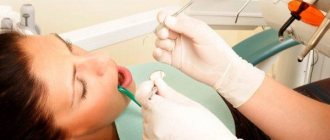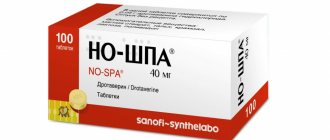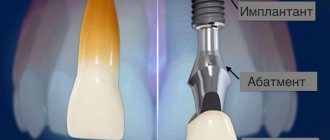The process of dental implantation is associated with a surgical intervention in the human body, during which an implant (a titanium pin simulating a tooth root) is installed in the jawbone, and then a crown is fixed to it.
Although implantation is not new as an effective and safe way to restore lost teeth using artificial roots, some people still consider it a painful procedure and prefer classic prosthetic solutions. Is dental implantation really painful? Let's try to understand this issue.
Dental pin: what is it, its advantages and disadvantages
What is a dental post? This is a specialized dental structure that looks like a rod. It is installed into the tooth root as a support for a filling or crown. Installation of a pin is only possible if the tooth has a healthy root. As a rule, this design is used if the tooth is badly damaged and thin walls remain.
Advantages:
- reducing the load on the tooth root;
- the ability to restore the crown in just one visit to the dentist;
- ease of installation;
- high level of aesthetics of the future artificial tooth;
- relatively low cost.
Flaws:
- instability under heavy chewing loads;
- there is a risk of damage to the root walls;
- allergic reactions and the development of secondary caries are possible;
- metal rods can only be removed together with the tooth.
To successfully install the pin, the following conditions will need to be met:
- the length of the rod must be at least 2/3 of the length of the dental canal;
- the size of the rim of healthy tooth tissue is at least 2 mm;
- root canal treatment was carried out with high quality;
- the root canal was given a cylindrical or conical shape.
How to install the pin? Does it hurt?
If you have entrusted dental treatment or prosthetics to a doctor from a clinic with a good reputation, there is no need to worry. We are sure that you will not experience any unpleasant sensations. First, the doctor will examine the tooth, decide on the use of a pin, and tell you how the installation will proceed.
If the root canal is filled, it will need to be unfilled to place the pin. This is followed by direct installation and fastening of the pin with a composite material.
Once the material has hardened and the pin is securely fastened, the doctor can begin restoring the shape of the tooth. If a pin is used on a front tooth, you should pay special attention to the restoration so that the shades of the restored tooth and the “neighbors” located next to it match, and the artificial tooth does not stand out from the series due to color.
How long does it take to install a pin and how painful is this process?
The duration of the procedure directly depends on the initial condition of the oral cavity. If there are no problems, the pin is placed in one visit to the dentist. If periodontal diseases and other pathologies are present, a pin will be installed in the tooth root only after they have been eliminated.
Since the doctor touches soft tissue during the implantation of the supporting element, the procedure is often accompanied by painful sensations. The occurrence of pain after nerve removal is a natural process. But if a long-depulped tooth hurts, it is possible that the rod has entered too deeply into the canal. X-rays will help identify the cause of the pain.
Teeth extension techniques
There are several modern methods of teeth extension. The doctor will select the most suitable one after examining the patient. The choice will depend, first of all, on the degree of damage to the teeth.
Tooth extension with a filling
Photopolymer materials allow you to correct a small chip, crack in the enamel or a stain on it. They:
- match the natural color of the teeth,
- do not harm healthy dental tissues and oral mucosa,
- allow you to accurately recreate the damaged area,
- allow you to preserve the natural layer of enamel and nerves.
The procedure is affordable and does not take much time: a filling made from a special quick-hardening composition is installed on the chipped tooth.
Veneers and Lumineers
The use of these thin ceramic onlays, which hide tooth imperfections, is an artistic restoration.
Veneers visually enlarge teeth. To install them, the patient will have to visit the dentist at least 2 times so that the doctor:
- Selected the type of lining.
- Under anesthesia, I ground off the enamel at the installation site.
- Installed veneers with dental cement.
Lumineers hide darkened enamel, chips and cracks, and mask large spaces between teeth. They are thinner and lighter than veneers, their installation does not require grinding down the enamel, and removal does not harm it.
Tooth extension with a crown
If the tooth is almost completely destroyed, previous restoration methods will be ineffective. In this case, the doctor installs a crown.
Extension on a pin
If the tooth is seriously damaged, it is built up onto a pin. Doctor:
- Refers the patient for an x-ray.
- A pin - a rod made of titanium or fiberglass - is implanted into the bone tissue of the tooth.
- Forms the visible, crown part of the tooth.
How much tooth extension costs will depend on the complexity of the case and the chosen technique.
Indications and contraindications for installing pins
Indications:
- damage to the tooth crown by more than 50%;
- the need to create support for prostheses;
- tooth loss;
- weakening of the tooth due to dental diseases.
Contraindications:
- untreated caries;
- the presence of inflammatory processes in the area of the tooth root;
- root destruction;
- blood diseases;
- insufficient thickness of the root canal;
- the presence of caries and periodontal inflammation;
- granulomas, cysts;
- exacerbation of systemic diseases;
- pregnancy;
- allergy.
It is important to know. The choice of the most suitable type of pin is always up to the doctor. It is unacceptable to focus only on the cost of the dental structure.
What are pin structures?
According to their shape, the pins are divided into:
- Screw;
- Cylindrical;
- Cylindrical-conical;
- Conical.
By fixation method:
- Using a special solution;
- The core base is strengthened in dentin.
Main types of structures:
- Anchor. The reliable fixing element is made of titanium alloy.
- Fiberglass. Durable but flexible. Resistant to corrosion. They do not show through the tooth. Hypoallergenic and safe.
- Carbon fiber. Distributes loads evenly. Minimizes pressure on the root.
Individual models are considered the most reliable. They are developed taking into account the characteristics of the patient’s dental cavity.
Pin Installation Procedure
How to install a pin in a tooth? The procedure occurs in several stages:
- Removal of all dental tissues affected by caries.
- Preparing the bed for the pin using a special reamer and calibration cutter.
- Root canal preparation.
- Fitting the rod to the tooth.
- Installation of the pin; dual-curing adhesive is used as a fixing element.
- Restoration work using a crown or prepared filling material.
The Saint-Dent Clinic in Moscow offers a wide range of dental services for adults and children. The current cost of services can be found here, the contact page is located here.
Advantages and disadvantages
Positive aspects of the installation:
- a decaying tooth retains its shape;
- in the future, you can build up the tooth stump to install ceramic crowns;
- it becomes possible to restore the enamel;
- This way you can prevent tooth extraction;
- The pins are durable and should be replaced no earlier than every ten years.
There are many advantages to high-quality installation of pins
The disadvantages of this design include the following:
- the pin can become one of the causes of tooth decay;
- if the rod is installed incorrectly, it can cause caries;
- metal pins are susceptible to corrosion from external factors;
- allergies and pin rejection may occur;
- over time, the walls of the tooth become thinner, which leads to the subsequent removal of damaged teeth;
- installing a pin is a fairly expensive procedure, especially when using modern materials.
Unfortunately, there are also negative aspects to such a procedure.
Possible complications
- severe pain, swelling;
- root fracture;
- restoration chips;
- the occurrence of a local allergic reaction to the material from which the rod is made;
- development of the inflammatory process (stomatitis, periodontitis);
- cyst development;
- fistula formation;
- mechanical damage to the walls of the tooth, which can lead to perforation of the root canals;
- splinters from dental instruments getting into the root canal.
It is important to know. The most dangerous complication is rejection of the installed supporting element by the body. In this case, it must be completely removed from the oral cavity.
Why does pain occur after installation?
The causes of pain with a pin installed cannot be identified on your own. If you notice that after implantation the tooth area begins to hurt, be sure to make an appointment with a doctor.
Pain occurs due to unprofessional or erroneous actions of the dentist.
- The pin is set too deep. The pain is felt during physical impact (for example, chewing) and has an aching character.
- During installation, the dental canal was cleaned with errors, and the walls of the tooth were damaged.
- The filling material has not completely filled the root canal. It could also simply extend beyond the apical foramen.
- When a fragment or several fragments are found in the canal belonging to endodontic instruments.
- In case of poorly performed disinfection of the canal during the procedure.
There are many reasons why pain occurs after insertion of a pin.
Important ! When installing the pin, the doctor requires high concentration.
During cleaning, it is necessary to use all the necessary instruments and identify the position of the apical foramen. To monitor the condition, an additional x-ray is prescribed.
In addition to incorrectly performed medical procedures, there may be other causes of painful sensations.
Normally, aching pain in a tooth can last up to several days; over time it subsides and disappears completely. Sometimes the pain is associated with an allergy, when the body does not accept the material from which the pin is made. In such cases, x-rays usually show the real picture.
Some discomfort after the procedure is normal.
If pain is not observed immediately after the intervention, but after a long period, for example, after several years, then the reasons that led to its occurrence may be as follows.
- Failure to maintain proper oral hygiene.
- Minor damage to tooth tissue (usually occurs due to biting nuts and other hard objects, opening lids with teeth, etc.).
- Periodontal inflammation.
- The appearance of cysts on the roots of teeth.
- Serious tissue damage.
Video - Dentist about pain in a tooth without a nerve
- How long does it take for drugs to leave the body?
What to do if a tooth with a pin hurts
In the first hours, rinsing the mouth with a soda solution (1 teaspoon of soda per glass of water) will help relieve toothache. A decoction of chamomile and sage has a similar effect. You can also take painkillers and apply ice to your cheek in the area where the pin was placed.
It is important to know. The occurrence of slight swelling and pain in the first days after installation of the pin is normal. But if these symptoms persist for a long time and the patient experiences an elevated body temperature, you should consult a dentist.
Are there any contraindications for pin prosthetics technology?
Yes, like any serious medical procedure, this one also has a number of contraindications. First of all, they are related to the condition of the patient’s gums: periodontitis, as well as all kinds of granulomas and cysts.
Those who know about the presence of allergic reactions in their body should be especially careful when installing pins. Since the pin will be in contact with your tissues, it will be better if you are firmly confident that you are not allergic to its material.
The most common questions about pins and answers to them
Is it always possible to get by with a pin?
Unfortunately no. In case of significant tooth decay, when there is a risk of further destruction of the coronal part, dental prosthetics are recommended.
How to care for your teeth after having a pin installed?
For two weeks, it is not advisable to eat too hard food and use toothpicks. When brushing your teeth, you need to be as careful as possible so as not to injure your gums.
Is there an alternative to a dental post?
Yes, you can install a stump tab instead. This is a microprosthesis, the lower part of which is fixed into the root canals, and the upper part serves as a supporting element for an artificial crown.
Seal + pin = Error?!
Since 1792, dentists have been searching for the perfect tooth post. Almost 300 years have passed, and the mythical perfect pin has not been found. Is it really necessary?
Valentina Vladimirovna Khalyavka, general director and orthopedic dentist of the Dental Clinic “Dentist”, speaks about the problem of treating periodontal diseases. (Article from the archives of the magazine “Women’s Health” Copyright entirely belongs to dentist V.V. Khalyavka)
Features of dental pinning, or why specialists at the Dentist clinic prefer more modern tactics.
Filling with a pin - what is it?
Increasing the strength of a tooth means extending its life. One of
The most popular solution to this problem for a long time was the use of pins. They are a ready-made structure that looks like a threaded rod. After expanding the canal mechanically, the pin is fixed directly into the canal of the tooth root, with cement, or screwed in like a screw, after which the remaining stages of restoring the damaged tooth are carried out. A filling with a pin is very often used in practice by dental therapists without a crown and orthopedic dentists with a crown.
IMPORTANT:
Pinning teeth and covering them with a crown is a gross orthopedic mistake, as well as a therapeutic one, which in the future will lead the patient to tooth extraction with subsequent implantation. That is why the most modern dental centers opt for other technologies.
Crown or filling on a post.
The question of which is better, a pin with a filling or a crown, is still relevant for many dentists. However, clinic specialists
“Dentist”, based on long clinical studies and personal observational experience, consider the choice in favor of dental pinning to be unsafe and extremely harmful. In clinical studies, it was proven that a filling on a pin leads to the removal of teeth in 70% of patients. Extraction (removal) of teeth in the roots of which metal pins were installed was carried out in connection with a root fracture. The reason for this is that pinning negatively affects the biomechanics of the tooth. During the endodontic protocol (treatment), the canal is widened, which has an acceptable limit. When a pin is installed, the expansion of the canal goes beyond the permissible limits and the walls of the tooth root become very thin. Inserting a pin into the root leads to a wedging effect. When chewing, the action of external forces becomes excessive, deformations occur, which lead to rupture or fracture of the root. Extraction (removal) of teeth in the roots of which metal pins were installed was carried out due to a root fracture.
IMPORTANT:
According to specialists at the Dentist clinic, the use of pins in everyday practice is a gross mistake, which in the future will lead to tooth extraction.
Thanks to modern technologies and the use of the latest generation of light materials (Enamel and Estet-X), our doctors carry out large dental restorations without the use of pins
. Restorations, like fillings made from the latest generation materials, serve their owners for a long time, more than 15 years!
For teeth with severely damaged coronal parts, we recommend core inlays
made of metal, inlays made of composite materials and zirconium dioxide. These additional expenses will definitely pay off in that you will not soon have to resort to tooth extraction where a filling was previously installed on a pin, further installation of a bridge structure, or implantation. Patients fully support this approach and consider the clinic one of the best in Moscow, which is clearly reflected in their positive reviews.
What dangers and harm does dental pin therapy pose for patients?
I began my career as a therapist-orthopedist-dentist after graduating from dental institute and residency 25 years ago. Few people know that the work of a dentist of any specialty requires the doctor to have in-depth knowledge of physics, namely mechanics and biomechanics, strength of materials and chemistry. And this is not without reason. Did I surprise you?! The entire chewing function of the jaw apparatus operates and works according to the laws of physics. Ignorance by a dentist of the basics of physics and mechanics leads our patients to tooth extraction, breakage of orthopedic structures, rejection of implants, and everything that is called medical error!
Until now, I am faced with metal pins twisted into the canals of the tooth, a “dentist” and I see the consequences that lead to fracture of the roots of the teeth, decementing of crowns, bridges and always, as a result, removal! Patients pay special attention to the issue of preserving natural teeth. The desire to preserve teeth for a long time also increasingly extends to those teeth whose crowns are severely damaged.
IMPORTANT:
Patients are not certified specialists in the field of dentistry; they often do not understand the principles of this or that treatment path, and in fact they should not understand!! They turned to a specialist dentist who will explain, suggest and help!
And so the “walk through agony” begins. A song as old as the world that “dead teeth” (the nerve has been removed) are very fragile and they must be strengthened with a metal pin, or a non-metal one, it is simply necessary to reinforce them, since the filling will not hold, and crown and bridge! If today the dentist does not have knowledge and scientific evidence about the dangers of “pin therapy,” I will try to reach out to patients. After all, these are their teeth and they want to preserve them at any cost!
And how great it sounds: “A restored tooth with a pin will last much longer (at least 5-7 years) and will withstand increased chewing loads.
IMPORTANT:
The opinion that: “Restorations using root pins are a good treatment method that sufficiently ensures fixation of the restoration during orthopedic work” is deeply erroneous and has long been outdated!
Scientific research.
"Long-term clinical studies that have been conducted
Axelsson et al.
(1991) over a 15-year period clearly showed that pins and screws placed in the root canal had an adverse effect on the prognosis of the tooth. At the same time, a total of 71 teeth were removed from 59 patients, of which 48 teeth (69%) were removed after endodontic treatment and installation of a root pin. Extraction of these teeth was performed due to a root fracture. Also Eckerbom et al. (1991) indicated in their clinical studies, which were carried out over 5-7 years, that the rate of extraction of teeth in the roots of which metal pins were installed was higher than that of teeth without a root post.” All these research observations were always available, and each doctor could obtain reliable information if desired.
It has been proven that the root post:
- Does not stabilize the tooth root or strengthen it.
- Does not contribute to the retention of the filling in any situation.
- Does not contribute to the redistribution of load during chewing.
Consequences of the pin + filling design.
- Weakens the root due to its strong expansion.
- The pin + seal makes the structure heavier.
- Leads to root fracture - fracture.
- Removal followed by prosthetics and implantation.
- Corrosion of stainless steel pins, which leads to tooth root fracture.
Why do all pins negatively affect the root of the tooth?
From the physics course we know that all solids experience deformation: shear, compression, bending, torsion. Depending on the material, each item has its own margin of safety. Strength is the ability of a material to resist destruction and for everyone it has its own limit. When carrying out endodontic treatment, we are forced to intervene in the biomechanics of the tooth. Carry out instrumental treatment, namely expansion of the canal. But there is a permissible limit of expansion, beyond which we actually weaken the foundation of the tooth. The human tooth, like the bone (periodontal) in which it is located, experiences elastic deformation, compression and tension deformation during chewing, but perceives it adequately. But as soon as the action of external forces becomes excessive, plastic deformations occur, which lead to destruction.
IMPORTANT:
When installing a screw pin, a wedging effect is created, the pin moves, uneven distribution of the chewing load and, as a result, root rupture.
But what about elastic pins? Yes, apparently they at least guarantee that the tooth root will not be torn in the future. And there is no convincing evidence about the benefits of these pins.
What is the price of pin therapy?
Pinning teeth and covering them with a crown is a gross orthopedic mistake, as well as a therapeutic one, which in the future will lead the patient to tooth extraction with subsequent implantation. This is such a high price for something harmless and not so
an expensive filling made of medium quality material on a pin! Modern technologies and high-quality materials make it possible today to carry out large dental restorations without the use of pins
.
Restorations, like fillings made from the latest generation materials, serve their owners for a long time. For teeth with severely damaged coronal parts, there are more durable and safe designs: core inlays, inlays made of composite materials and zirconium dioxide.
Of course, these are additional costs, but they are worth it, since you will not have to start traditional bridges or implants in two years or less.
IMPORTANT: The patient considers the situation hopeless, the way out of which he does not like.
Dentistry has firmly become commercial in the 21st century, and competition is very high in the market for these services.
There is nothing wrong with that and this is natural. The question is about the quality of services, their adequacy and benefit for the patient? I never followed the lead of patients, and did not allow roles to be changed; the patient became a doctor, the doctor became the executor of his desires. This is an important point, and the material aspect has never been a priority for me in such situations. The moral and professional aspects have always been the leading ones for me when working with such patients, and there were quite a few of them. The answer was and is always the same: “Apparently, you need a doctor of “higher qualification” and “with a different level of knowledge”!!” “The only thing satire should do is alarm. If the addressee of satire is not complete……., he will be wary, sensing arrows” Alexander Shirvindt.
Put crowns on teeth: prices in Moscow
How much does it cost to put a crown on a tooth - the price in Moscow for 2021 (in economy-class and mid-price clinics) can have a very wide range. For example, you can easily see that in one clinic you can install a dental crown made of metal ceramics for 5,500 rubles, while in another the price can be 10,000 rubles. And it’s not just a matter of pricing...
The fact is that the same crowns (for example, metal-ceramic) can be made of materials of completely different quality. For example, if a cheap ceramic mass is used, then we can immediately say that the aesthetics of such a crown will be very poor. In addition, in addition to standard metal-ceramics, there is also “metal-ceramics with shoulder mass”, which is much more aesthetically pleasing than the standard version, but at the same time costs 2-2.5 times more.
Installing a crown on a tooth: price 2021
- metal ceramics - from 4,500 to 16,000 rubles.
- ceramics made of zirconium dioxide – from 14,500 to 20,000 rubles.
- from E.max ceramics – from 16,000 to 25,000 rubles.
- all-metal crowns – from 4500 rubles.
Important: if you are planning to install a crown on a tooth, the cost above does not include all possible expense items. Additionally, therapeutic preparation of teeth (if necessary) is paid, as well as the cost of making temporary crowns made of plastic. The latter are necessary to protect the ground teeth while your permanent crowns are being made.











